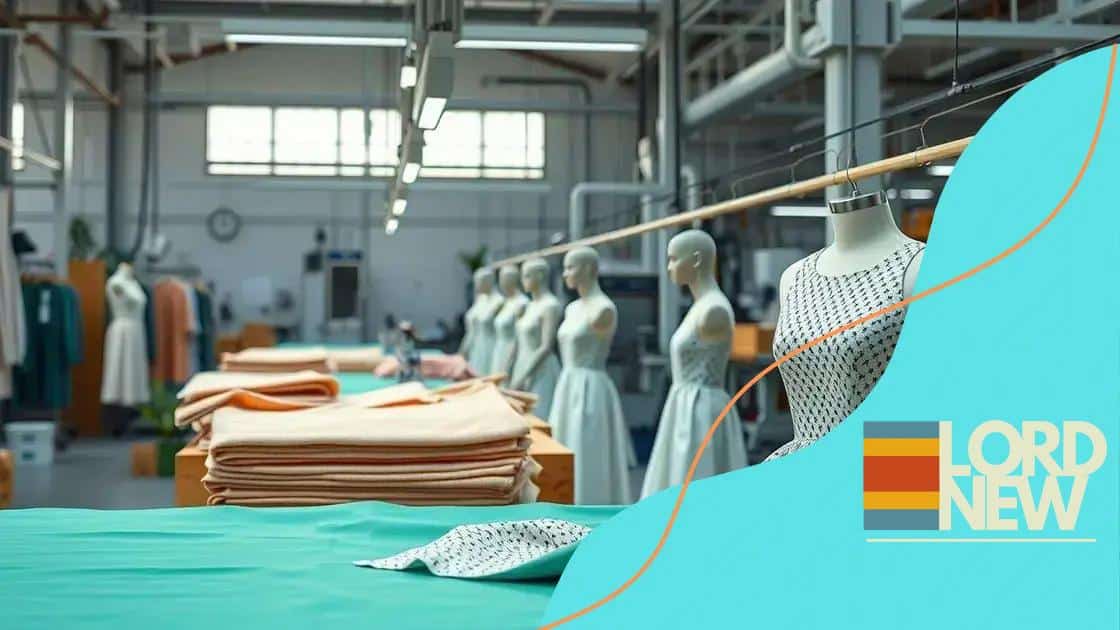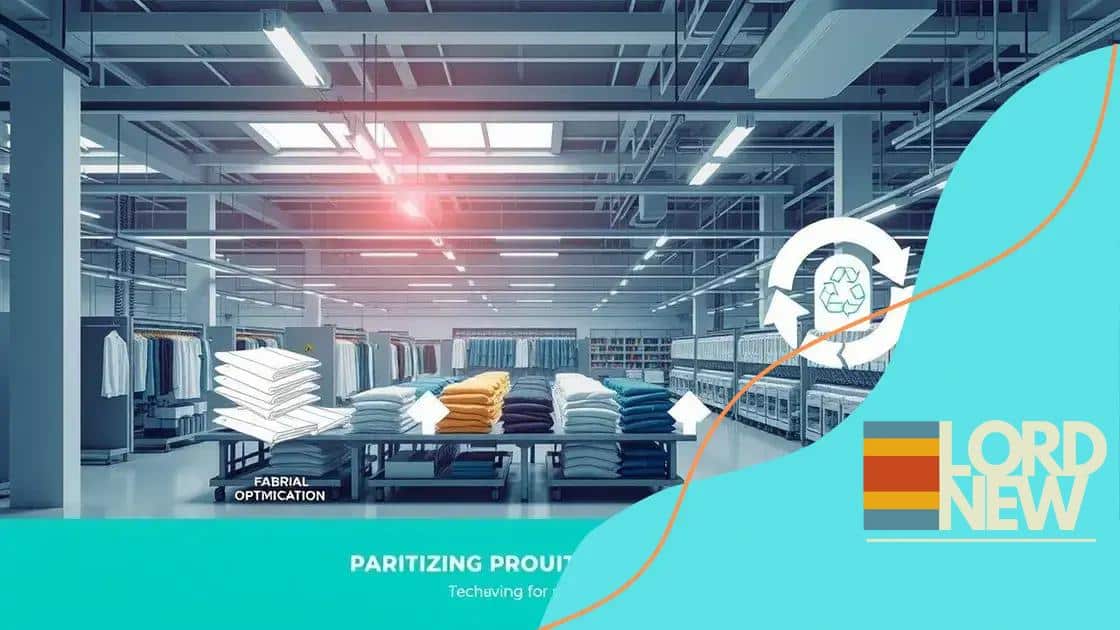Educational series on Shein’s sustainable production methods

Shein’s sustainable production methods focus on using eco-friendly materials, reducing waste through just-in-time manufacturing, and actively engaging consumers to promote awareness of sustainability in the fashion industry.
Educational series on Shein’s sustainable production methods opens a window into how this popular brand is redefining eco-friendly fashion. Interested in the details? Let’s explore what makes their practices stand out.
Understanding Shein’s approach to sustainability
Understanding Shein’s approach to sustainability is essential to comprehend how this brand is reshaping the fashion industry. With growing concerns about environmental impact, Shein is adapting its business model to embrace more eco-friendly practices.
Sustainable Practices at Shein
One critical area where Shein is making strides is the use of sustainable materials. This includes organic cotton, recycled polyester, and other innovative fabrics that reduce environmental damage. By switching to these materials, Shein aims to lessen the carbon footprint associated with traditional textile production.
Reducing Waste and Improving Efficiency
Another aspect of Shein’s sustainability efforts is waste reduction. The brand has implemented several strategies to minimize waste throughout its production process. For instance, Shein uses a technique called just-in-time manufacturing, allowing it to produce clothing only when there is demand, which significantly reduces excess inventory.
- On-demand production techniques
- Implementation of recycling programs
- Collaboration with eco-conscious suppliers
In addition to manufacturing, Shein places emphasis on packaging. The use of biodegradable materials for packaging is one way the company hopes to reduce its environmental footprint. Such initiatives demonstrate a commitment to sustainable practices that can influence consumer behavior and promote environmental awareness.
Consumers play a crucial role in Shein’s sustainability journey. By choosing to support brands that prioritize eco-friendly practices, buyers can help drive change in the industry. Shein’s initiatives are not just about compliance; they reflect a broader movement towards responsible fashion. As the brand continues to evolve, it offers insights into how large companies can make a positive environmental impact.
Key sustainable materials used by Shein
Key sustainable materials used by Shein highlight the company’s commitment to environmental responsibility in the fashion industry. By incorporating eco-friendly materials, Shein is making strides towards reducing its ecological footprint.
Types of Sustainable Materials
One of the main materials Shein uses is organic cotton. This cotton is grown without harmful pesticides, making it better for both the environment and the health of farmers. In addition to organic cotton, Shein utilizes recycled polyester, which is derived from plastic bottles. This process helps to reduce plastic waste and conserves water compared to virgin polyester production.
Innovations in Fabric Choices
Another exciting innovation is the use of fabrics made from recycled materials. These include textiles crafted from upcycled materials, lowering the demand for new resources. By choosing this type of fabric, Shein not only reduces waste but also conserves energy during production.
- Use of Tencel™ for its biodegradable properties
- Incorporation of linen, which requires less water to grow
- Adoption of other sustainable fibers, like hemp
Sustainable materials are becoming increasingly important in the fashion industry. Shein recognizes this need and strives to make a positive impact. As consumers become more aware of their choices, the push for brands to adopt eco-friendly practices continues to grow. This shift is essential for encouraging a more sustainable approach to fashion, moving away from fast fashion towards solutions that benefit the planet.
How Shein reduces waste in production

How Shein reduces waste in production is a key aspect of its sustainability efforts. By implementing innovative strategies, Shein aims to minimize waste throughout its manufacturing processes.
Just-in-Time Manufacturing
One effective method Shein uses is just-in-time manufacturing. This approach means that items are produced as needed, reducing excess inventory. By aligning production closely with consumer demand, Shein prevents overproduction that often leads to waste.
Efficient Use of Resources
Shein also focuses on maximizing resource efficiency. This includes optimizing the use of fabric, where patterns are designed to minimize the leftover material after cutting. By doing so, Shein decreases fabric waste significantly. This attention to detail ensures that the company maximizes every yard of material purchased.
- Implementation of strict inventory controls
- Regular audits to identify and reduce waste points
- Partnerships with suppliers to ensure sustainable practices
In addition to these practices, Shein is committed to recycling programs. The brand encourages customers to return used clothing for recycling. This initiative not only helps keep textiles out of landfills but also promotes a circular fashion economy. By supporting such practices, Shein actively fosters a culture of sustainability.
Overall, Shein’s commitment to reducing waste in production plays a critical role in its efforts to create a more sustainable fashion industry. The brand recognizes that responsible practices are not just beneficial for the environment but also resonate with consumers who value sustainability.
The impact of Shein’s practices on the fashion industry
The impact of Shein’s practices on the fashion industry is significant as the company reshapes how clothing is produced and consumed. By leveraging fast fashion strategies, Shein has transformed consumer expectations and challenged traditional retail models.
Changing Consumer Behavior
Shein’s business model encourages rapid purchasing and trend-driven consumption. This has led to a culture where shoppers expect new styles every week. As a result, many consumers are more likely to buy clothes impulsively, influenced by social media and influencers.
Redefining Supply Chains
Another impact of Shein is on global supply chains. By adopting a fast fashion approach combined with technology, Shein has shortened production times significantly. This allows the brand to respond quickly to market trends, but it also raises concerns about sustainability and labor practices.
- Increased demand for transparency in the supply chain
- Greater emphasis on ethical sourcing and manufacturing practices
- Rethinking traditional fashion seasons and cycles
Moreover, Shein’s rise has prompted discussions about sustainability in the fashion industry. As brands strive to keep up with Shein’s model, the need for eco-friendly practices has become more pressing. Many companies are now looking to adopt sustainable materials and production methods to appeal to environmentally conscious consumers.
Overall, Shein’s practices are pushing the fashion industry towards a rapidly changing landscape. As more consumers become aware of the environmental impact of their purchases, the pressure is on brands to adapt and innovate. This creates a dynamic market where sustainability and fast fashion coexist, forcing traditional brands to reevaluate their strategies.
Consumer awareness and Shein’s sustainable initiatives
Consumer awareness and Shein’s sustainable initiatives are crucial in the modern fashion landscape. With more consumers becoming eco-conscious, brands like Shein are adapting their practices to meet these expectations.
Increasing Demand for Transparency
Consumers today want to know where their clothes come from and how they are made. Shein has recognized this shift and is making efforts to provide more transparency in its production processes. This includes sharing information about the materials used and the methods of production.
Engaging with Consumers
Shein actively engages with its customers through social media. This platform allows the brand to communicate its sustainability initiatives and gather feedback from consumers. By fostering a dialogue, Shein can better understand what customers care about, which helps shape its sustainable practices.
- Promoting eco-friendly collections
- Running campaigns to educate consumers on sustainable fashion
- Implementing recycling programs for clothing returns
Moreover, as consumers demand more sustainable choices, Shein is responding by collaborating with third-party organizations to improve its practices. These partnerships help enhance credibility and show a genuine commitment to sustainability.
Shein’s initiatives are not only about creating new clothing lines but also about encouraging responsible consumption. By raising awareness and providing educational resources, the brand aims to influence how consumers think about fashion and sustainability.
FAQ – Frequently Asked Questions about Shein’s Sustainable Practices
How is Shein reducing waste in its production processes?
Shein uses just-in-time manufacturing to minimize overproduction and ensures efficient use of materials to reduce waste.
What sustainable materials does Shein use?
Shein incorporates organic cotton and recycled polyester among other eco-friendly fabrics in its products.
How does Shein engage with consumers regarding sustainability?
Shein actively engages with consumers through social media, promoting its sustainable initiatives and encouraging feedback.
What impact do Shein’s practices have on the fashion industry?
Shein’s approach impacts consumer behavior and supply chains, pushing the fashion industry towards greater sustainability and transparency.





